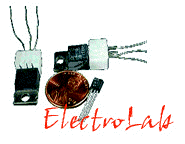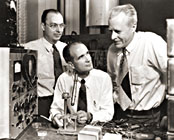






![]()
JUNCTION FIELD EFFECT TRANSISTOR:
DEVELOPMENT
click here to learn more about the scientific aspects of this
transistor
I t was in 1945 that William Shockley first thought of it. He thought of an idea that was to revolutionise the design of transistors forever. He reasoned that if you could create a strong electrical field outside of a semiconductor, it could cause another electrical current to flow inside of it. He tried to do this, and even asked a colleague of his, John Bardeen to build one too, but both of them failed in their attempts.
 He soon forgot about this theory,
which he called the field-effect theory. Soon after, Walter Brattain, as well as
fellow scientist John Bardeen, built the first working transistor, which was dubbed the
germanium point contact transistor. Later, Shockley developed the junction transistor
(also called the "sandwich" transistor), which basically took over from the
point contact transistor. These two transistors readily replaced vacuum tubes, and the
science world was fairly content with this brilliant new invention, the transistor. But
Shockley's field effect theory still lay dormant, almost forgotten. It was not until 1960,
when a scientist at Bell, John Atalla, revived the old field effect theory and developed a
new type of transistor based on Shockley's theories that was far more practical than the
older transistors. The Field Effect Transistor is now the most used transistor type in the
modern world.
He soon forgot about this theory,
which he called the field-effect theory. Soon after, Walter Brattain, as well as
fellow scientist John Bardeen, built the first working transistor, which was dubbed the
germanium point contact transistor. Later, Shockley developed the junction transistor
(also called the "sandwich" transistor), which basically took over from the
point contact transistor. These two transistors readily replaced vacuum tubes, and the
science world was fairly content with this brilliant new invention, the transistor. But
Shockley's field effect theory still lay dormant, almost forgotten. It was not until 1960,
when a scientist at Bell, John Atalla, revived the old field effect theory and developed a
new type of transistor based on Shockley's theories that was far more practical than the
older transistors. The Field Effect Transistor is now the most used transistor type in the
modern world.
The earlier amongst the field effect transistors is the Junction Field Effect Transistor. It was based on a totally different principle from its predecessors. The result was that it totally revolutionised the further development of transistors. In other words, it might be called as the Father of Modern transistors!